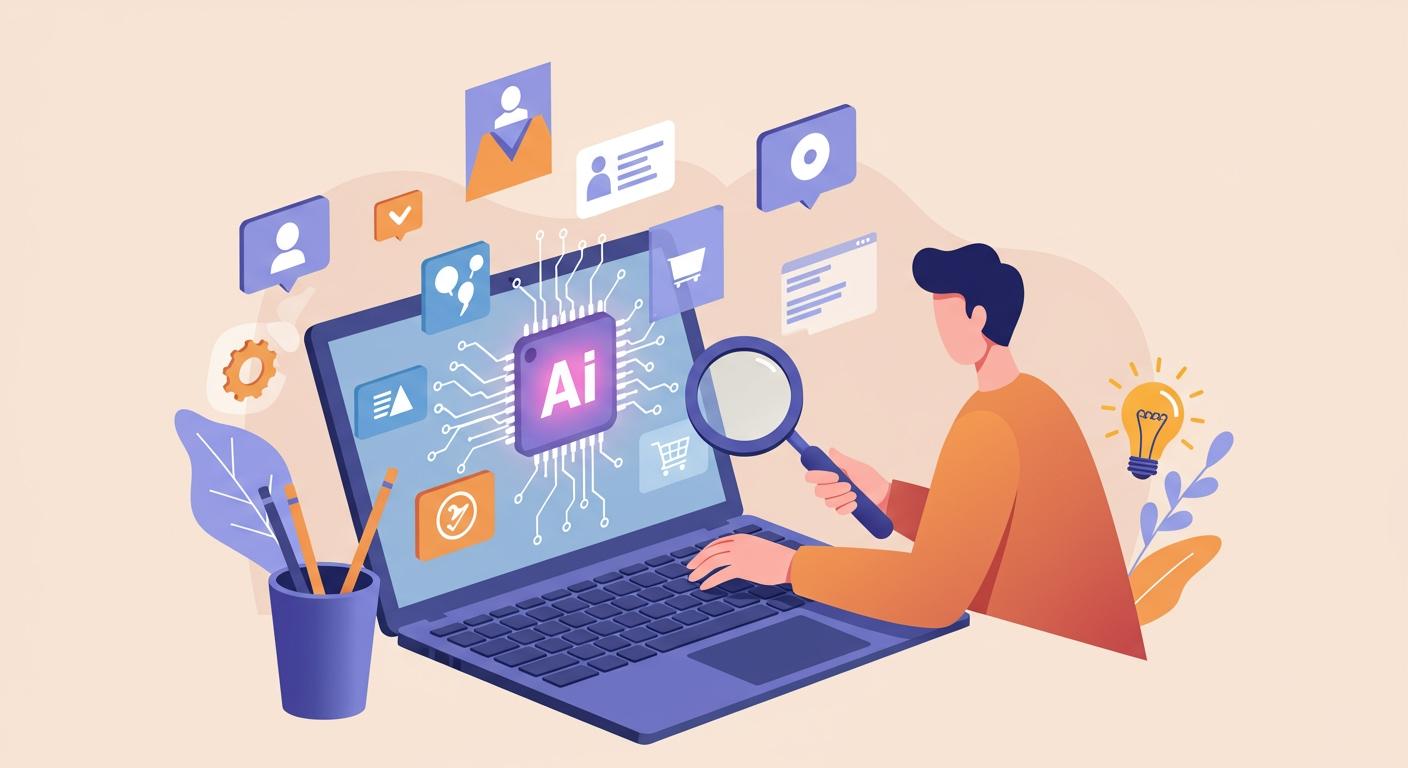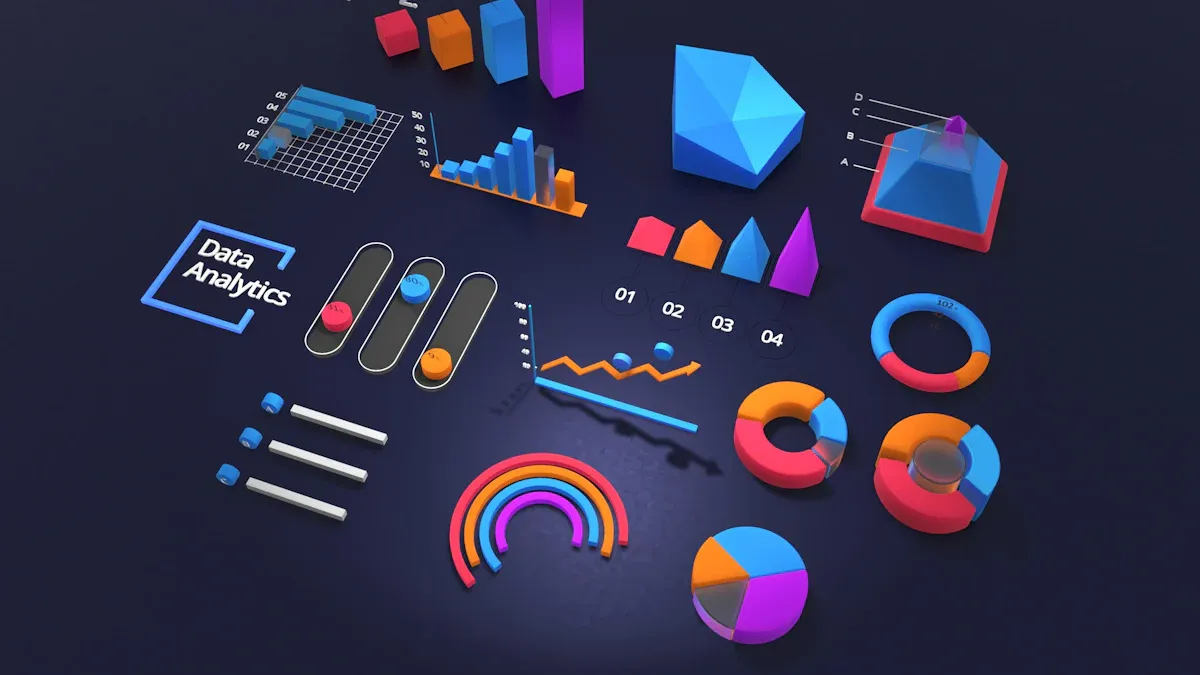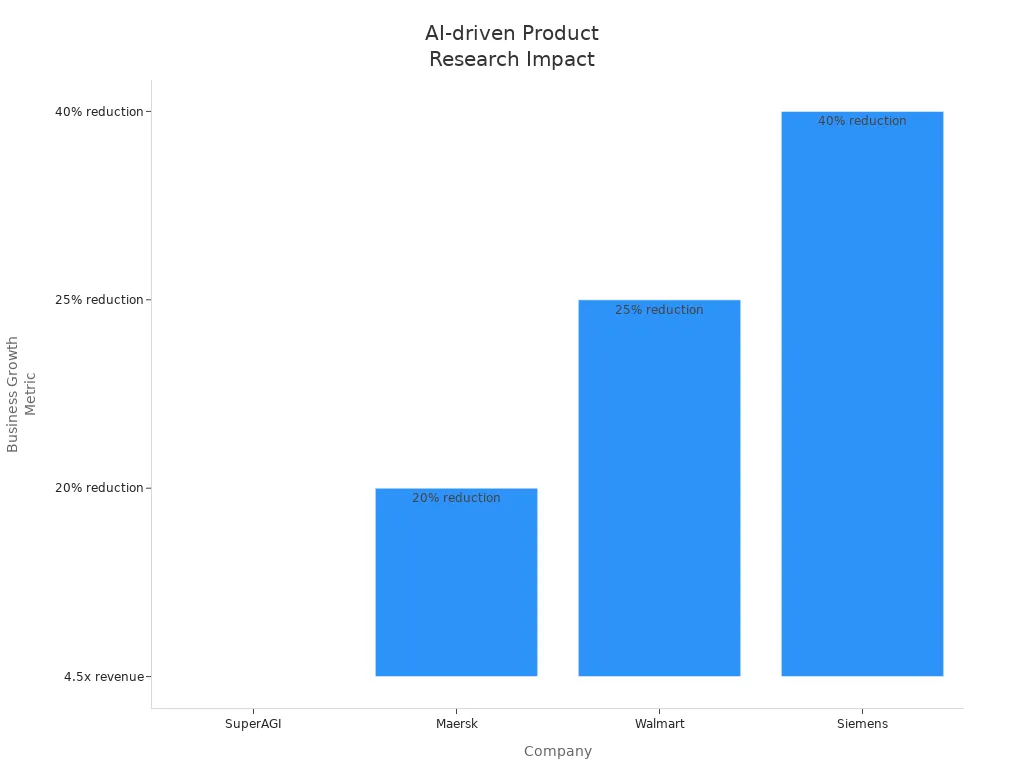What TikTok and Amazon Can’t Tell You — But AI Can: The Secret to Spotting Winning Products

You want to find winning products, but it feels impossible to know what will actually take off. TikTok and Amazon show you what’s trending, but they rarely reveal the full story. Did you know that most new launches never make it past their first year?
Around 80-95% of new products flop within twelve months.
Tech gadgets fail about 90% of the time.
85% of consumer-packaged goods disappear after a year.
AI changes the game. It spots patterns you might miss and helps you discover what works before the crowd catches on.
Key Takeaways
AI helps you find good products early. It spots trends before they get big. Look for special products that fix real problems. This helps you stand out in the market. Products with high demand and little competition do better. You have a better chance to succeed with them. Community feedback is very important. Listen to what users say to make your products better. Use social media to see new trends. Change your plan fast if you need to. Test products before you launch them. This helps you avoid big mistakes and improve your ideas. Pick AI tools that match your business needs. This makes product research easier. Use AI insights and your own judgement together. This helps you make the best choices.
Winning Products Defined
You might ask what makes winning products special. It is not only about trends or looking cool online. Some products have clear traits that help them stand out and do well.
Key Attributes
Uniqueness
People like things that are different. Products with new ideas or that fix problems in new ways get noticed. Unique features or stories make people talk and share with friends. If you find a product that feels special, you are ahead.
High Demand
High demand means more sales. Products that fix big problems or make life easier sell fast. Look at this table to see what experts say about top product traits:
Characteristic | Description |
|---|---|
High Demand | Products that fix big problems and sell more. |
Low Competition | Fewer sellers means better chances for new sellers. |
High Profit Margins | Products bought cheap and sold for much more, often over 50%. |
High Quality | Strong, safe, and useful products that meet what customers want. |
Visually Appealing | Good-looking products that catch buyers’ eyes. |
Easy to Ship | Products that ship easily, both in the country and abroad. |
Advertising Friendly | Items that can be shown on social media without problems. |
Emotionally Appealing | Products that connect with what customers care about. |
Problem-Solving
Winning products fix real problems. If something helps your daily life or solves a small issue, people talk about it. Products with clear benefits get noticed and shared quickly.
Consumer Needs
You want products that fit your life. The best sellers usually do a few things:
They fix big problems.
They help you connect with others.
They get used quickly.
They make life easier.
Social currency matters a lot. When you share something cool or helpful, friends notice. Products with special features or stories make people talk and share. Convenience is important too. If a product saves time or effort, you will want to tell others.
Community Feedback
Feedback from users helps products do well for a long time. You can spot a winner by seeing what people say online. Here is what matters most:
Evidence Type | Description |
|---|---|
Community Insights | Regular feedback and requests help make products better. |
Trust and Loyalty | A good user experience builds trust and keeps users coming back. |
Product Improvement | Active feedback leads to changes that match what users want. |
Knowledge Sharing | Users talk and share ideas, which builds a strong group. |
User Empowerment | Gives users tools and chances to learn, making them like the product more. |
You should look at ratings, reviews, and chats. These show what people like, what needs fixing, and how loyal they are. Products that listen to users and keep getting better often become very popular.
Traditional Methods
Amazon Best-Sellers
You probably check Amazon’s best-seller lists when you want to spot new products. This method feels easy and quick. You see what’s selling right now, and you get a sense of what people like. Many sellers use manual product searches on Amazon and other big marketplaces to find popular items. You can scroll through categories, look at ratings, and read reviews. Sometimes, you notice patterns in what buyers want. Market research platforms also help you spot winning products by showing you what’s trending across different regions.
Amazon’s best-seller lists have strengths. You get real sales data, and you see what’s hot in each category. You can compare products side by side. However, there are some weaknesses. The lists only show what’s already popular, not what’s about to trend. You might miss new products that haven’t gained traction yet. Also, competition is fierce. When you find a product on these lists, many other sellers have already noticed it.
TikTok Trends
TikTok makes products go viral overnight. You see videos of people using new gadgets, beauty items, or quirky tools. Sometimes, a product explodes in popularity because of a single influencer. You can spot trends by watching what gets shared and liked. TikTok trends move fast, and you need to act quickly if you want to catch them.
Let’s look at how long these trends last:
Trend Type | |
|---|---|
Flash Fads | 2-4 days |
Micro-trends | 3 weeks to 2 months |
Trend Forces | 2 months to several years |
Flash fads disappear almost as soon as they arrive. Micro-trends stick around for a few weeks or months. Trend forces can last much longer, sometimes years. If you chase TikTok trends, you need to watch closely and move fast. The downside? Trends can vanish before you even launch your product. You risk investing in something that fades away quickly.
Social Media Insights
Social media gives you a front-row seat to what people want. You see posts, comments, and videos about new products every day. By analysing competitor websites, you can find top-performing products and see what’s getting attention. Social media insights offer immediate feedback on consumer preferences and behaviours. You get a sense of what’s popular before sales data catches up.
Here’s why social media insights matter:
You get instant feedback from real users.
Analysing sentiment helps you understand customer satisfaction.
User-generated content reveals new trends and shifts in behaviour.
Social media lets you spot emerging trends early. You can adjust your strategy before the market changes. However, social media buzz doesn’t always lead to sales. Sometimes, products get lots of likes but few buyers. You need to balance hype with real demand if you want to find winning products.
Competitor Monitoring
You can learn a lot by watching your competitors. When you keep an eye on what others are doing, you spot new ideas and see what works in the market. You might notice a product feature that stands out or a marketing trick that grabs attention. This helps you find ways to make your own products better.
Here are some strengths of competitor monitoring:
You spot what makes your competitors’ products special. This helps you stand out.
You find gaps in the market. Sometimes, your competitors miss things that you can use to your advantage.
You get ideas to improve your marketing and product features by seeing where others fall short.
But there are some weaknesses too:
It can be hard to get the latest and most accurate information about your competitors.
You might spend a lot of time collecting and checking data from different places.
The market changes quickly, so you need to keep updating your research to stay ahead.
If you want to find winning products, you need to look beyond just copying others. Use what you learn to create something better or different. Remember, the goal is not just to follow but to lead.
Product Testing
Testing products before you launch them is a classic way to see what works. You might give samples to friends, run small ads, or sell a few items online to see how people react. This hands-on approach gives you real feedback from real users.
Product testing sounds simple, but it is not always a sure thing. Many products that pass early tests still struggle in the market. In fact, almost half of new products disappear after just 26 weeks. After a year, only about one in four products are still around. This shows that even with testing, success is not guaranteed.
Here are some tips for better product testing:
Start small. Test with a few people first.
Listen to feedback. Change your product if people spot problems.
Watch for patterns. If many people like or dislike the same thing, pay attention.
Product testing helps you learn fast and avoid big mistakes. It is a key step if you want to spot winning products before they become popular.
Platform Limitations
You might think TikTok and Amazon give you all the answers, but these platforms have some big blind spots. If you rely only on what you see there, you could miss out on the next big thing. Let’s break down the main problems you face when using these platforms for product research.
Data Gaps
You want clear data to make smart choices, but both Amazon and TikTok often leave you guessing. For example, Amazon Attribution links do not always track every visitor from TikTok. You might run a TikTok campaign and see a spike in sales, but you cannot always prove where those buyers came from. This makes it hard to know which platform drives real results.
You also face trouble matching what’s trending on TikTok with what’s actually available on Amazon. Sometimes, you spot a hot product in a TikTok video, but you cannot find it in stock or with the same features on Amazon. This gap makes it tough to jump on trends before they fade.
Traditional Amazon research tools only show you what is already selling well. You end up fighting for the same products as everyone else. The market gets crowded, and your chances of standing out drop fast.
Trend Volatility
Trends on TikTok move at lightning speed. One day, a product is everywhere. The next day, it’s old news. If you want to catch a trend, you need to act quickly. TikTok’s fast-changing trends can make product discovery feel like a race.
Here’s a quick look at how trends behave on each platform:
Platform | Trend Dynamics | Impact on Product Discovery |
|---|---|---|
TikTok | Rapid spikes and crashes | Less stable environment for product discovery |
Amazon | Gradual trend evolution | More stable environment for product discovery |
TikTok encourages you to buy on impulse. You see a product, and you want it right away. Amazon works differently. Trends grow slowly, and buyers take more time to decide. If you only follow TikTok, you risk chasing products that disappear before you can even launch them.
TikTok’s trends change quickly, so you must stay alert.
The platform pushes you to act fast, but that can lead to mistakes.
Amazon’s trends move slower, giving you more time to plan.
Surface-Level Insights
You might think you’re getting the full picture from likes, shares, and comments. In reality, these numbers only scratch the surface. Social platforms often limit your reach unless you pay for ads. Their analytics tools show you basic stats, like how many people saw your post or clicked a link, but they rarely tell you why people buy.
Limitation | Description |
|---|---|
Decreasing organic reach | Algorithms hide your posts unless you pay for promotion |
Basic analytics | Only show surface-level metrics like impressions and likes |
Inaccurate social data |
You can get overwhelmed by too much data. It’s easy to focus on the wrong numbers. Superficial engagement does not always mean real interest or sales. Sometimes, bots or fake accounts inflate your stats, making it hard to know what’s real.
Tip: Don’t trust every number you see online. Always dig deeper to find out what’s really driving sales.
If you want to spot winning products, you need more than just surface-level insights. You need tools that go beyond the basics and help you understand what buyers truly want.
AI and Winning Products

Data Analysis
You want to find products that will sell. Looking at lots of data can be hard. AI helps with this problem. AI tools look at huge amounts of information very quickly. You get answers fast and they are more correct than doing it by hand.
AI checks big datasets quickly and makes fewer mistakes.
These tools let teams share ideas in one place. You can change plans fast when the market moves.
AI surveys often get 70-90% of people to finish them. Old surveys only get 10-30% to finish.
AI cuts down on bias and works with lots of data. This means your results are more trustworthy.
Old ways use human judgement. People can miss things or make errors.
AI can look at user interviews and feedback right away. You decide faster and with better facts.
You do not need to wait a long time for reports. AI gives you answers when you need them. This speed and accuracy help you spot winning products before others do.
Consumer Behaviour
Knowing what people want is important. AI helps you see how shoppers act and what they buy. You can use this to guess what will be popular soon.
AI predictive analytics looks at old sales and other things. You can use this to plan stock and serve customers better. For example, AI can:
Use maths to study old sales and guess future sales.
Use machine learning to find patterns people miss.
Watch social media to see what people say about products.
You can see this in many industries:
In retail and e-commerce, AI checks sales and stock. You keep the right products and do not run out.
In consumer goods and manufacturing, brands use AI to guess what customers will want. This helps them make better products.
When you use AI to study behaviour, you see what people want more clearly. You can act before trends are easy to spot.
Pattern Recognition
Finding patterns is something AI does well. You might not see links between products or needs, but AI finds them fast. This helps you find new chances that others miss.
Here is a table with top AI techniques for pattern recognition in product discovery:
ML Technology | Function | Benefit |
|---|---|---|
Collaborative Filtering | Finds patterns in customer behaviour | Discovers unexpected product relationships |
Content-Based Filtering | Analyses product attributes | Matches features to customer preferences |
Deep Learning Networks | Processes complex, multi-dimensional data | Handles nuanced customer requirements |
Reinforcement Learning | Optimises based on conversion outcomes | Continuously improves recommendation accuracy |
Collaborative filtering shows what products people buy together. Content-based filtering matches products to what customers like. Deep learning networks look at tricky data and spot small trends. Reinforcement learning keeps making your recommendations better.
AI has found winning products where old research did not work. For example, AI has found new drug targets in cancer research by using lots of data. Some platforms have guessed new uses for drugs by looking at gene patterns and trial results. These wins show how AI can find chances people miss.
Tip: Let AI do the hard work. You can think of creative ideas while AI finds the patterns that help you win.
Predictive Insights
You want to know what will sell before everyone else does. That is where predictive insights from AI come in. AI does not just look at what is popular now. It looks at patterns, numbers, and behaviour to guess what will be big next. You get a head start because AI can spot trends before they explode.
Imagine you have a tool that checks millions of data points every day. It looks at sales, reviews, social media, and even weather. AI connects the dots much faster than any person. You do not have to guess or hope. You get clear signals about which products could become the next big thing.
Let’s see how AI compares to human experts when it comes to predicting success:
Analysis Type | Human Accuracy | |
|---|---|---|
Statistical analysis | 95-99% | 85-95% |
Pattern recognition | 90-98% | 70-85% |
Predictive modelling | 85-95% | 75-90% |
Business interpretation | 60-70% | 85-95% |
Strategic recommendations | 45-60% | 80-90% |
You can see that AI beats humans in crunching numbers and finding patterns. It is not as strong when it comes to business strategy or making big-picture decisions. That is where your own experience and gut feeling still matter. But for spotting winning products early, AI gives you a huge advantage.
Here is how you can use predictive insights in your search:
Track early signals. AI finds small changes in buying habits before they turn into big trends.
Test ideas quickly. You can run small campaigns and let AI tell you which ones show promise.
Avoid dead ends. AI warns you if a product is losing steam, so you do not waste time or money.
Note: AI does not replace your judgement. It gives you better information, so you can make smarter choices.
You might wonder if AI ever gets it wrong. Sometimes it does, especially when things change fast or when people act in new ways. That is why you should use AI as a guide, not a rulebook. Combine its insights with your own research and feedback from your community.
When you use predictive insights, you do not just follow the crowd. You lead it. You spot winning products before they show up on best-seller lists or go viral on social media. That is how you stay ahead and build a business that lasts.
AI Product Research

Tool Selection
You want to pick the right AI tool for product research. There are many choices, and it can feel confusing. The best tools help you see trends and understand what customers want. You do not need to be a tech expert to use them. Many platforms are easy to use and show clear results.
Here are some popular AI tools for e-commerce:
Hypotenuse AI writes product descriptions for online shops. It costs from £44 each month.
Zoho Analytics gives you predictive insights and uses natural language processing. You must ask for the price.
Qualtrics XM offers deep analysis and useful insights. You need to request pricing.
These tools help you do tasks automatically and guess what customers want. You get a better view of your market. You save time and do not have to guess. You can look for winning products instead of sorting lots of data.
Tip: Pick a tool that matches your business size and goals. You do not need the priciest option to get good results.
Research Criteria
When you choose an AI tool, you should know what matters most. Successful e-commerce businesses use clear rules to help them decide. You want a platform that grows with you and gives you the insights you need.
Here is a simple list of things to look for:
Scalability and Flexibility: The tool should handle more sales and data as you grow.
Data Analysis and Insights: You want strong analytics and clear advice you can use.
Personalisation Capabilities: The tool should help you tailor products and messages for each customer.
Customer Support and Service: Good support helps you fix problems quickly.
Security and Compliance: Keep your customer data safe with strong security.
Integration Capabilities: The tool should work well with your other systems and platforms.
Cost Efficiency: Make sure the tool saves you money or helps you earn more.
Vendor Support and Community: A strong support network helps you get the most from your tool.
You do not need every feature at the start. Begin with what matters most for your business. As you grow, you can add more tools or upgrade your platform.
Note: Always read reviews and ask other sellers about their experiences. Real feedback helps you avoid expensive mistakes.
Data Gathering
You want to collect data from many places to find the best products. AI makes this much easier. You can gather information from websites, social media, and APIs. The right tool helps you manage all this data without getting lost.
Here is a table that shows how AI tools handle big product data:
Aspect | Description |
|---|---|
Scalability | Handles big datasets and adapts to different types of data. |
Integration Complexity | Manages data from many sources with unique formats. |
Real-time Data Capture | Collects and processes data as it arrives from different platforms. |
Pre-built Connectors | Offers ready-made connectors to save time and effort. |
Data Quality Management | Keeps data reliable and up to date for analysis. |
Governance Features | Maintains data quality and follows rules for compliance. |
AI systems need lots of structured data to work well. You can collect this data from websites, social media, and APIs. Good data collection includes quality checks and strong rules. This keeps your results correct and trustworthy.
AI has changed how you handle data. You can clean, sort, and study information much faster. Smart algorithms help you spot trends and guess what will sell next. This makes it easier to grow your business and find winning products before others do.
Tip: Start with a small dataset and grow as you learn. Make sure your data is clean and reliable for the best results.
Product Validation
You have found a product idea with AI. Now, you need to check if it will work in the real world. Product validation helps you avoid wasting time and money on ideas that do not have real demand. You want to make sure people actually want what you plan to sell.
AI makes this step much easier. You can use AI tools to test your ideas before you spend a lot. These tools give you early access to what users think. You can see if your product solves a real problem or if people just like the idea.
Here are some ways you can validate your product with AI:
Test and verify market demand before you invest fully. This means you check if people want your product.
Check the quality of your data. Run your analysis again to see if you get the same results. Look at a sample of comments or reviews to make sure the feedback is real.
Use AI to get early user insights. You can ask for opinions or run small tests before you build the full product.
You can also use AI to run quick surveys or polls. Ask your target audience if they would buy your product. Create a simple landing page and see if people sign up or show interest. Sometimes, you can even pre-sell the product to test if people are willing to pay.
Tip: Always sanity check your results. Do not trust only the numbers. Look at real comments and feedback to see if your idea has true support.
If you follow these steps, you will know if your product has a real chance. You will spot winning products before others do.
Testing and Feedback
Once you have validated your idea, you need to test it and gather feedback. AI helps you do this faster and with better results. You want to know how people use your product and what they think about it.
Businesses use AI in many ways to test new ideas before launch. Here is a table that shows some common methods:
Method | Description |
|---|---|
Market Data Analysis | AI speeds up research by finding and studying market data to see if there is demand. |
Customer Persona Creation | AI helps you build detailed profiles of your ideal customers. |
User Journey Mapping | AI shows you how customers move from interest to purchase and finds pain points. |
Rapid Prototyping | AI lets you create and test product versions quickly, so you can improve faster. |
You can also try these simple steps:
Run surveys or polls with your target audience to see if they like your idea.
Make a landing page or try to pre-sell your product. This shows if people are ready to buy.
Launch a small pilot or a basic version (MVP) to get real feedback and improve your product.
AI tools help you collect and study feedback quickly. You can spot problems early and make changes before a big launch. This saves you time and money.
Note: Listen to what users say, not just what the data shows. Real feedback helps you build products people love.
Testing and feedback are key steps. They help you turn good ideas into winning products that last.
Practical Tips
Avoiding Pitfalls
You want to use AI for product research. It is easy to make mistakes. Many people rush and miss important details. If you know the usual problems, you can avoid them and do better.
Here is a table with common problems when using AI for product research:
Pitfall Type | Description |
|---|---|
Data Quality Issues | Bad data and not enough real-world examples make models weak and biased. |
Proof-of-Concept Trap | Many AI projects stay as tests and never become useful tools. |
Deployment Challenges | Moving from test to real use brings problems like speed, size, and cost. |
Ethical and Legal Issues | Big models can make bias worse and face legal trouble about data and privacy. |
Misalignment with Business Goals | New technology may not match business plans, so projects can fail. |
Always check your data before you trust results. Make sure your AI project fits your business goals. If you skip these steps, you might waste time and money. Remember, AI is a tool, not magic.
Tip: Start small, test ideas, and fix problems early. This helps you avoid big mistakes later.
Combining AI and Intuition
AI can find patterns and trends. You still need your own judgement. When you mix AI insights with your own thinking, you make better choices. You get the best of both worlds.
AI looks at lots of data and spots trends you might miss.
You use your experience to decide if those trends work for your business.
AI can guess what might sell, but you know if it fits your brand or customers.
Data visualisation tools help you see the big picture, so you can trust your gut.
Decision support systems give you options, but you choose what feels right.
You can use AI to test ideas, then use your own knowledge to pick the best ones.
Using both AI and your own skills helps you avoid bias and make fair choices.
Feedback from AI and people helps you learn and improve over time.
Note: Trust your instincts, but let AI do the hard work. You make the final choice.
Staying Ahead
You want to stay ahead of others. Top companies use AI in smart ways to spot trends and act fast. You can do the same by following their lead.
Here is how top brands use AI to stay ahead:
Company | Strategy Description |
|---|---|
Tesla | Uses AI for self-driving cars, showing new ideas in automotive. |
Netflix | Uses AI for content suggestions and personalisation, checking what people watch to match content with users. |
Amazon | Uses AI for stock management and personalised shopping, guessing product demand and improving delivery. |
You can also use these ideas:
Automate testing to launch better products faster.
Personalise your offers based on what users like.
Use predictive analytics to plan for the future.
If you keep learning and trying new things, you will always be ready for the next big trend. AI helps you move quickly, but your ideas and actions keep you ahead.
Tip: Stay curious and open to change. The best businesses never stop learning.
AI Case Studies

Success Stories
You might ask if AI really helps with product research. Many companies have seen big changes. When you use AI, you can spot trends and manage stock better. You can also increase sales. Here are some real examples:
Company | AI Technology Used | Result |
|---|---|---|
SuperAGI | AI-driven sales agents | |
Maersk | 20% reduction in shipping times | |
Walmart | Predictive analytics | 25% reduction in stockouts |
Siemens | AI-driven demand forecasting | 40% reduction in stockouts |
Coca-Cola | AI-driven analytics | Improved supply chain operations |
SuperAGI made $4.50 for every $1 spent on AI. Maersk made shipping 20% faster. Walmart and Siemens had fewer empty shelves. Coca-Cola moved products better around the world.

Some companies got a huge return on investment. If you use AI for personalisation, you could get up to 300% ROI. One online shop made 25% more money in six months. AI supply chain tools helped others cut inventory costs by 15%. These numbers show that AI helps you grow your business faster and smarter.
Tip: Start with one thing, like stock management or customer insights. You do not need to change everything at once to see results.
Lessons Learned
AI does not always work perfectly. Sometimes, projects fail. You can learn from these mistakes and avoid common problems.
Reason for Failure | Percentage of Firms |
|---|---|
Model did not perform as promised | |
Lack of production-ready data pipeline | #2 reason |
Poor data quality | Among top three |
Many firms found their AI models did not work as planned. About 35% said the technology did not deliver what they wanted. Some did not have the right data pipelines, so their systems could not run well. Messy data also caused trouble. If your data is not clean, your AI will not give good answers.
Unrealistic hopes often lead to disappointment. You should know what AI can and cannot do.
Always test and check your AI tools before making big decisions.
Good data is important. Make sure your information is clean and current.
You can avoid most problems by starting small and checking your results. If you learn from others, you will have a better chance of success with AI.
Note: AI is powerful, but it works best when you use your own experience and get regular feedback from your customers.
Future Trends

Emerging Tech
You see new technology changing the way you find winning products every day. AI keeps getting smarter. You now have tools that can scan thousands of products in seconds. Machine learning helps you spot patterns that you would never notice on your own. You get predictions about what will sell next, even before the trend starts.
Voice search is growing fast. People ask their phones or smart speakers for product ideas. You can use AI to make your products easier to find with voice commands. Augmented reality (AR) lets you try products before you buy. You can see how a lamp looks in your room or how a pair of trainers fits your style. This makes shopping more fun and helps you choose better.
Blockchain is another tech you should watch. It helps you track where products come from. You know if something is real or fake. This builds trust with your customers. You can also use blockchain to show how your products are made, which helps you stand out.
Here’s a quick look at some tech trends you should keep an eye on:
Technology | What It Does | Why It Matters |
|---|---|---|
AI & Machine Learning | Finds patterns and predicts trends | Helps you spot winners early |
Voice Search | Lets people shop by speaking | Makes products easier to find |
Augmented Reality | Shows products in real life | Boosts buyer confidence |
Blockchain | Tracks product origins | Builds trust and loyalty |
Tip: Try new tech early. You get ahead of your competitors and learn what works best for your business.
Market Shifts
You notice that shoppers want more than just good prices. People care about quality, speed, and how products fit their lives. You see more buyers asking for eco-friendly options. They want products that last longer and do not harm the planet. You can use AI to find these trends and offer what people want.
Social commerce is growing. You see people buying straight from social media apps. TikTok, Instagram, and Facebook let you shop without leaving the app. You can use AI to track what’s popular on these platforms and adjust your offers quickly.
Personalisation is key. Shoppers expect products and ads that match their tastes. You can use AI to send the right message to the right person. This makes people feel special and keeps them coming back.
Here are some market shifts you should watch:
Eco-friendly products are in demand.
Fast delivery matters more than ever.
Social media shopping is rising.
Personalised experiences win loyalty.
Note: Stay flexible. The market changes quickly. You need to listen to your customers and use AI to keep up with new trends.
You can spot winning products by watching these shifts and using the latest tech. You stay ahead when you learn, adapt, and use smart tools.
You’ve seen how AI helps you spot winning products faster and with less guesswork. You get deeper insights, spot trends early, and avoid common mistakes. When you mix AI with your own experience and listen to your community, you make smarter choices.
Try an AI tool for your next product search.
Ask for feedback from real users.
Trust your instincts, but let data guide you.
Ready to find your next best-seller? Start exploring AI-driven product research today!
FAQ
What is a winning product?
A winning product sells well and stands out. You spot it because people want it, talk about it, and buy it again. It solves a problem or feels special.
How does AI help me find winning products?
AI looks at lots of data fast. You get trends, customer feedback, and predictions. AI shows you what people want before everyone else notices.
Can I use AI tools without tech skills?
You do not need to be an expert. Many AI tools have simple dashboards. You click, search, and get results. Some even offer step-by-step guides.
Is AI better than checking Amazon or TikTok trends?
AI gives you deeper insights. You see patterns and future trends, not just what’s popular now. You make smarter choices and avoid chasing short-lived fads.
How much does an AI product research tool cost?
Prices vary. Some tools start at £40 per month. Others charge more for extra features. You pick what fits your budget and business needs.
Will AI replace my own judgement?
No, AI helps you make decisions. You still use your experience and gut feeling. The best results come when you mix AI insights with your own ideas.
What mistakes should I avoid with AI product research?
Check your data. Start small. Do not trust every number. Always test your ideas and listen to real feedback. AI is a tool, not magic.
Can AI help me test new product ideas?
Yes! You run quick surveys, create landing pages, or launch small pilots. AI collects feedback and shows you what works. You learn fast and improve your products.

TangBuy: A Smarter Way to Dropship in 2025
If you're looking to stay competitive with dropshipping in 2025, speed and trend-awareness are key. TangBuy helps you stay ahead with real-time product trends, fast fulfilment, and factory-direct sourcing. With over 1 million ready-to-ship items, 24-hour order processing, and seamless Shopify integration, TangBuy makes it easier to test, scale, and succeed in today's fast-moving eCommerce landscape.
See Also
Top TikTok Advertising Tools Every Marketer Needs in 2025
Five Innovative Ways to Find Hot Products for Your Store
Unveiling the Hidden Truths of eBay’s Best Antiques
Current Hot Products to Maximise Your Profits This Year
Effective Strategies for Selling Successfully on Amazon 2025

